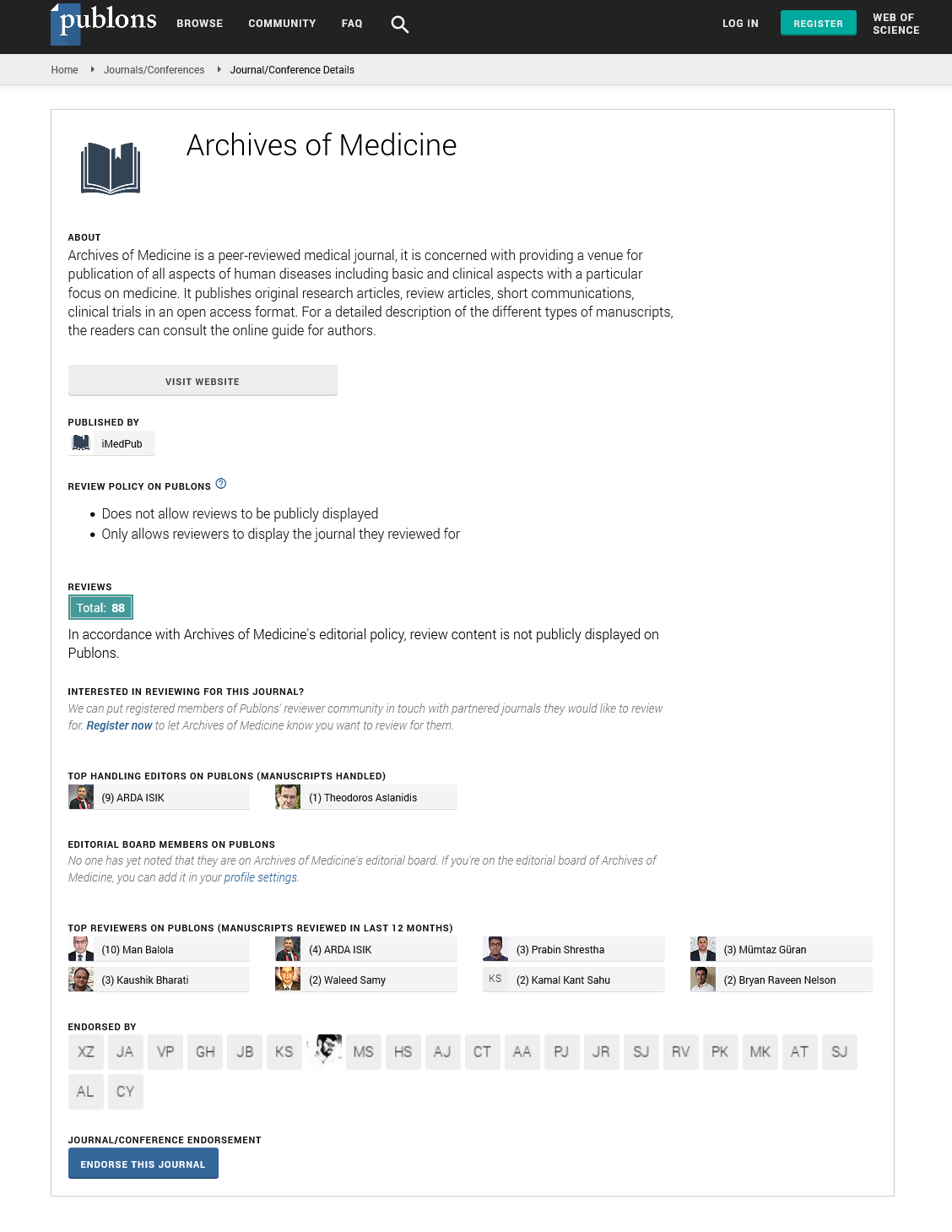Opinion - (2025) Volume 17, Issue 1
Bridging gaps in primary care with telemedicine: Challenges and solutions
Olivia Harris*
1Department of Family Medicine, University of Sydney, Camperdown, Sydney, New South Wales, Australia
*Correspondence:
Olivia Harris, Department of Family Medicine, University of Sydney, Camperdown, Sydney, New South Wales,
Australia,
Email:
Received: 03-Jan-2025, Manuscript No. ipaom-24-15470;
Editor assigned: 06-Jan-2025, Pre QC No. P-15470;
Reviewed: 17-Jan-2025, QC No. Q-15470;
Revised: 22-Jan-2025, Manuscript No. R-15470;
Published:
29-Jan-2025
INTRODUCTION
Telemedicine, the use of telecommunication
technology to provide healthcare services remotely,
has rapidly transformed the landscape of healthcare
delivery. The increasing reliance on telemedicine is
particularly evident in primary care settings, where access
to healthcare professionals and services can be limited
by geographic, economic, and logistical barriers. The
adoption of telemedicine has the potential to bridge
these gaps in primary care, especially for patients in rural
or underserved areas, while offering convenience, costeffectiveness,
and improved healthcare access. However,
despite its promising benefits, there are several challenges
that need to be addressed to fully realize its potential.
These challenges include technological barriers, issues
related to reimbursement, regulatory concerns, and the
need for integration with traditional healthcare systems.
To successfully integrate telemedicine into primary
care, it is essential to identify these barriers and explore
effective solutions. This article discusses the current
role of telemedicine in primary care, highlights the key
challenges it faces, and proposes potential solutions to
ensure its effective implementation and widespread
adoption [1].
DESCRIPTION
Telemedicine in primary care involves the use of digital
tools such as video consultations, remote monitoring
devices, and telehealth platforms to deliver healthcare
services. It enables patients to interact with healthcare
providers without needing to visit a clinic or hospital,
offering convenience and flexibility, especially for those
with limited mobility, chronic health conditions, or living
in remote areas. In addition, telemedicine can reduce the
strain on healthcare facilities and providers by enabling
more efficient patient management, such as through
virtual consultations and follow-up appointments.
By facilitating access to healthcare professionals,
telemedicine also has the potential to improve early
diagnosis and reduce the burden of preventable diseases.
Despite its clear advantages, telemedicine is not without
its challenges. One of the most significant barriers is the
issue of technological infrastructure. Reliable internet
access is a prerequisite for telemedicine to function
effectively, and in many rural and low-income areas,
access to high-speed internet remains limited. Without
the necessary infrastructure, patients may struggle to
access telehealth services, and healthcare providers
may face challenges in delivering services that are clear
and effective. Moreover, not all patients have the
technological literacy required to engage in telemedicine
consultations, which could exclude a significant portion of
the population, particularly the elderly or those who are
not familiar with digital tools [2].
Another key challenge is reimbursement.
Telemedicine services, especially in primary care, have
historically been underfunded compared to in-person
visits. While some countries and health systems have
made strides in reimbursing telemedicine services,
the reimbursement structure is still inconsistent, with
policies differing across regions and insurers. In many
cases, healthcare providers may not be compensated
adequately for the time and resources spent delivering
telemedicine services. This lack of reimbursement can
discourage healthcare professionals from fully embracing
telemedicine, as it may not be financially viable for their
practice. Additionally, the reimbursement rates for
telemedicine are often lower than those for in-person
visits, creating a financial disincentive for providers to
offer telemedicine consultations. Regulatory issues also
pose a significant hurdle to the expansion of telemedicine
in primary care. The regulation of telemedicine is complex
and varies by region, with different laws governing the
use of telemedicine across state and national borders.
For example, in some countries, there are restrictions
on cross-border telemedicine services, meaning that
a doctor in one country may not be legally allowed to
provide telemedicine services to a patient in another
country. Similarly, some regions have strict regulations
surrounding the privacy and security of health data
transmitted through telemedicine platforms, which can
create barriers to implementing these technologies.
Healthcare providers and organizations must navigate
these regulatory requirements to ensure they are
compliant with local laws and provide safe, secure services
for patients [3].
Despite these challenges, there are several
solutions that can help bridge the gaps in primary
care through telemedicine. The first solution lies in
improving technological infrastructure. Governments
and healthcare organizations must invest in expanding
broadband access, particularly in rural and underserved
areas. By improving internet access and supporting
the development of affordable technology, healthcare
systems can ensure that more patients can access
telemedicine services. Moreover, providers should be
offered training in the use of telemedicine platforms
and digital tools to enhance their technological literacy,
ensuring that both patients and healthcare professionals
are equipped to use telemedicine effectively. Addressing
reimbursement issues requires policy changes at both
the government and insurer levels. Governments should
implement standardized reimbursement policies that
ensure healthcare providers are fairly compensated for
telemedicine consultations. By aligning reimbursement
rates for telemedicine visits with those for in-person
visits, policymakers can incentivize healthcare providers
to embrace telemedicine as a legitimate and financially
sustainable mode of care. Additionally, insurance
providers should work with healthcare organizations to
streamline the reimbursement process for telemedicine
services and ensure that patients are not burdened with high out-of-pocket costs [4].
Regulatory issues can be addressed through the
establishment of clear and consistent telemedicine
guidelines that prioritize patient safety, privacy, and
access to care. Governments can work with healthcare
regulatory bodies to develop national or international
standards for telemedicine, ensuring that the delivery
of telemedicine services is both legal and ethical. These
regulations should focus on protecting patient data,
ensuring that telemedicine platforms meet the necessary
security standards, and removing barriers to crossborder
telemedicine. By simplifying and harmonizing
the regulatory framework, policymakers can facilitate
the growth of telemedicine and encourage providers to
offer services with confidence. Finally, to maximize the
potential of telemedicine in primary care, healthcare
systems should invest in integrating telemedicine services
with traditional in-person care. A hybrid model of care,
where telemedicine is used for consultations and followup
appointments while in-person visits are reserved for
more complex cases, could help optimize healthcare
delivery. By integrating telemedicine into existing
healthcare structures, primary care providers can offer
more personalized and accessible care to their patients,
enhancing the overall patient experience and improving
health outcomes. The combination of in-person and
virtual care can also help alleviate the strain on healthcare
facilities and reduce patient wait times, improving the
efficiency of the healthcare system as a whole [5].
CONCLUSION
Telemedicine has the potential to revolutionize
primary care by providing patients with greater access
to healthcare services and reducing the burden on
healthcare facilities and professionals. However, the
successful implementation of telemedicine requires
overcoming several challenges, including technological
barriers, reimbursement issues, and regulatory concerns.
By addressing these challenges through investments
in infrastructure, policy reforms, and regulatory
improvements, telemedicine can be seamlessly integrated
into primary care systems. As the healthcare industry
continues to evolve, telemedicine will likely play an
increasingly important role in shaping the future
of healthcare delivery, offering more personalized,
accessible, and efficient care. With the right solutions in
place, telemedicine can bridge the gaps in primary care
and ensure that quality healthcare services are available to
all patients, regardless of their location or circumstances.
Acknowledgment
None.
Conflict Of Interest
None.
REFERENCES
- Beheshti L, Kalankesh LR, Doshmangir L, et al. Telehealth in primary health care: A scoping review of the literature. Perspect Health Inf Manag. 2022;19(1).
Google Scholar, Indexed at
- Etz RS, Solid CA, Gonzalez MM, et al. Telemedicine in primary care: Lessons learned about implementing health care innovations during the COVID-19 pandemic. Ann Fam Med. 2023 1;21(4):297-304.
Google Scholar, Crossref, Indexed at






